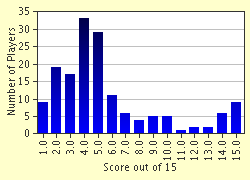Quiz Answer Key and Fun Facts
1. How many children did James VI (of Scotland) and I (of England) have by his wife, Anne of Denmark?
2. James I's eldest son, Henry Frederick, was created Prince of Wales, and apparently showed great promise, though he argued frequently with his father. He was close to his mother, and his sister Elizabeth, and his brother Charles looked up to him. As such, it was a great blow to all when he died in what year?
3. What was the title of Elizabeth's husband Frederick at the time of their marriage?
4. James I considered himself quite the diplomat, and once his daughter had a Protestant husband, he thought it would be a good idea to find his only surviving son, Charles, a Catholic wife. To this end, Charles and his father's current favourite, the Duke of Buckingham, left to woo the daughter of which of these Roman Catholics?
5. Meanwhile, in Germany in 1619, Elizabeth's husband Frederick had accepted the throne of Bohemia after a revolution against the Habsburgs, who ruled had previously rules Bohemia. His claim was soon under threat though, from which Habsburg Emperor?
6. Queen Anne of Denmark died in 1619; her husband outlived her by six years. On which date in 1625 did James VI and I die?
7. Who stood proxy for Charles when he was married to Henrietta Maria?
8. Henrietta Maria and Charles I's first child was born on 13 May 1629; what was the child's name?
9. What year did the Winter King, Elizabeth's husband, die?
10. Henrietta Maria presented Charles I with a daughter, Mary Henrietta, on 2 November 1631. The princess had the distinction of being the first British princess to be . . . what?
11. After ruling on his own for eleven years, Charles I was forced to recall parliament in 1640 due to his manifold financial troubles caused by a war with his Scottish subjects. How long did this parliament last?
12. Which act did parliament force Charles to give his royal assent to in February 1641?
13. What was the name and title of Charles's friend and councillor whom parliament impeached in 1641?
14. In the midst of this chaos, the King's eldest daughter the Princess Royal was married. But her husband was not the man her father had wanted for her. Who would Charles have preferred Mary to marry?
15. In January Charles I famously burst into the House of Commons to arrest five firebrand MPs only to find that 'the birds had flown'. Who had informed the MPs of the impending danger?
Source: Author
LiamR
This quiz was reviewed by FunTrivia editor
bloomsby before going online.
Any errors found in FunTrivia content are routinely corrected through our feedback system.


